Tomato Black Elephant: All About Growing
Gardeners are used to tomatoes have a standard color - red or pink. Therefore, someone treats new varieties with caution, while others with admiration. One of the latest novelties is the Black Elephant tomato. " He interested many farmers with his non-standard shade and a host of useful properties, mainly affecting men's health. Before planting, it is recommended to learn the important nuances of growing and planting it.
Content:
- Description and benefits of the variety
- Growing seedlings
- Transplanting seedlings into the ground
- Tomato care
- Disease and pest control
Description and benefits of the variety
The black elephant is a medium-ripening tomato. It belongs to the group of indeterminate tomatoes - unlimited growth. But generally its height does not exceed 1.5-2 meters in height. In the middle lane, it is excellently grown in greenhouse conditions. In the southern regions of Russia, it grows in open ground and bears fruit abundantly.
Features of the variety:
- The leaves on the shrubs are large in size, represented by a potato appearance and shape. The first flowers begin to form only after 9 full leaves. The rest of the inflorescences are alternately every 3-4 leaf plates.
- As they grow, tall shoots should be tied up or formed alongside a high trellis or support to support long trunks and weighty fruits. It is recommended to carry out pinchingso that the bush does not drive out a lot of unnecessary shoots, but directs all its nutrients to the formation of large tomatoes. The best option would be the formation of 2 powerful stems.
- The resulting fruits are slightly flattened, large, round in size. The tomato has a specific shade - brown with a red-brick shade. Each fruit reaches up to 300-350 gr. weight. The pulp is fleshy, rich, with a unique sourness and sweet aftertaste.
Tomatoes are used fresh in salads, soups or other dishes. They can also be canned and pickled, twisted onto a tomato. Use as sauces.
It is recommended to plant for seedlings 60-70 days before the intended planting in the open area of the personal plot.
The first fruits ripen within 3 months after planting in open ground. Thus, the Black Elephant is an interesting tomato variety that is capable of producing a large number of delicious fruits. And its exotic color decorates not only any dish, but also adds zest to the preparation of preservation.
Growing seedlings
Planting tomato seedlings Black Elephant begins with preparing the soil and a container for placing seedlings. The land can be purchased both in a specialized store, and you can cook it yourself.
In the first variant, all the necessary nutrients for the rapid germination of seeds have already been added to the soil. The disadvantage of purchased soil is the possibility of acquiring midge larvae or other parasitic microorganisms that can destroy a young sprout.
The best option is to prepare your own potting mix. It should include:
- Pressed peat (2 parts).
- Sod land (1 part).
- Humus (part 1).
- Superphosphate (2 matchboxes).
- Wood ash (500 gr.).
After preparation, it is recommended to spill the soil with a weak solution of potassium permanganate, then warm it up in the oven. This is necessary so that all pathogenic bacteria and harmful parasites are completely neutralized.
The next step before planting the seeds is to prepare them. If the seedlings are purchased, then they should not be specifically processed. They are equipped with an additional shell that stimulates the growth and development of young shoots. Such preparation is required for planting material purchased from hands or collected independently. To do this, it is necessary to prepare a solution of potassium permanganate in the calculation of 1 g. 0.1 l. liquids. Wrap the seedlings in cheesecloth, place the bag in a consistency for no more than 25 minutes. Longer exposure to the solution negatively affects the seeds - their germination decreases.
After disinfection, the planting material is recommended to be spilled with plain water.
The last step is sowing. A pot filled with earth is spilled with water to keep the soil moist. Inside, a groove is loosened, 1 cm deep.Each of the mini-trenches should be located at a distance of 3-4 cm from each other.The seeds are laid out in the groove, there should be a gap of no more than 2 cm between them.After placing the seedlings, they should be sprinkled top with soil.
The flowerpot is tightened with a film, a plastic bag or covered with glass. This is necessary to create greenhouse conditions and stimulate faster germination of seeds. For the first shoots to appear, you should adhere to a temperature of 25-27 C. Shy shoots will appear in 3-4 days. At lower degrees - in 5-6 days.
Transplanting seedlings into the ground
Seedlings are actively growing in flowerpots. Some dive into separate pots, others leave it until transplanted into open ground. Transfer to a new place of residence is carried out approximately 1.5-2 months after planting the seeds. This period is marked by the appearance of the first peduncles. If the inflorescences have formed on the bush, then after 7-10 days it is time to move the young seedling to a permanent place of growth.
To plant seedlings in the soil, the following rules should be followed:
- Dig holes at least 30-45 cm deep.
- The seedling is laid out in a horizontal room, and a support is driven in next to it. This is necessary in order for the stem to sprout adventitious roots, which it will additionally feed on, feeding the entire shrub. Support is necessary so that when the seedling rises, it immediately begins to form.
- The area between the black elephant tomatoes should be at least 50 cm. The shrubs grow strongly and prevent nearby seedlings from actively growing. In addition, space is required for the farmer to move and properly care for the tomatoes.
- The rows should be spaced 1 meter apart.
Thus, the correct placement of young seedlings guarantees their active growth and proliferation. If you do not follow the basic rules for landing, then tomato will be significantly thickened, which negatively affects the formation of the Black Elephant fruit. Lack of lighting has a detrimental effect on the fruit, leading to decay and the acquisition of diseases.
Tomato care
Tomatoes The Black Elephant is actively releasing a large number of stepchildren, they must be removed. If you leave them, then the plant will direct all its forces to forcing new shoots, minimally directing nutrients to the fruits. Therefore, in order to achieve large yields, it is recommended to prune the stepsons, while leaving small stumps so that the plant does not release new side shoots.
An obligatory moment in growing tomatoes is the removal of the lower foliage.
It should be removed because it rotts and is a prime breeding ground for pathogenic bacteria. Due to the elimination of the leaf plates of the lower rows, the plant is ventilated, and the foliage always remains dry.For abundant growth and active fruiting for tomatoes, the Black Elephant is important lighting... The more sunlight hits the fruits, the faster and tastier the tomatoes will be.
How to properly care for tomatoes:
- Watering plays an important role. It should be carried out not over the foliage, but under the root. If water remains on the surface of the sheet plate, then the sun's rays can provoke burns on the delicate surface. Watering is required abundant, so that the nutrient moisture reaches the lowest roots. The main thing is not to overmoisten the soil, otherwise you can provoke decay root system and the attachment of diseases.
- Be sure to periodically loosen the soil. This is required so that the water after watering does not stagnate, but quickly penetrates the rhizomes. In addition, by digging under the tomatoes, germinated weeds are eliminated, and the necessary oxygen is supplied in sufficient quantities.
When performing simple plant care, Black Elephant tomatoes delight with a large number of formed fruits and an original rich taste.
Disease and pest control
Black Elephant Tomatoes are very susceptible to various pests and pathogenic bacteria. In most cases, tomatoes suffer from the following diseases:
- Streakiness - the plant is covered around the entire perimeter with small stripes of a yellow tint. Flowers and young shoots crumble.
- Vertical wilt - the very first leaf blades located at the surface of the earth begin to turn yellow, fall off or curl ahead of time. Affected bushes inhibit development, but do not die.
- Late blight - on fruits and leaves, brown or brown spots of various sizes are formed. The disease grows in volume and affects the entire bush.
- Phomosis - brown spots with dents are formed on the fruits. Rotting of the fetus is observed.
- Bacterial spot - black blotches appear on the surface of leaves and fruits, they have the ability to increase in size and merge, forming irregular outlines.
In addition, Black Elephant tomatoes can be infested with parasites:
When fighting diseases and pests, it is recommended to use chemicals. In order to prevent the spread of either diseases or parasitic insects, it is necessary to constantly monitor the condition of the plant. If the primary signs of an incipient disease are detected, action is required immediately.
Thus, the Black Elephant tomatoes are large, tasty fruits of an interesting shade. They require planting for seedlings and only after growing to the optimum size can they be planted in the ground. Proper care and control over the condition of the plant will allow you to get a bountiful harvest in September.
More information can be found in the video:



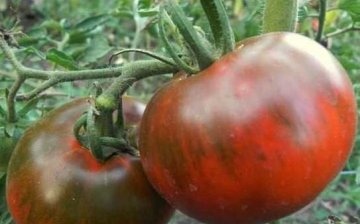
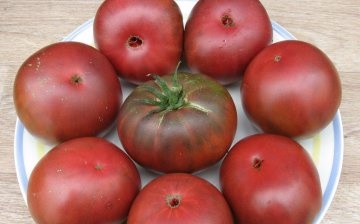
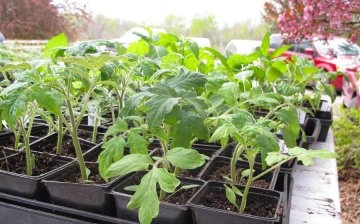
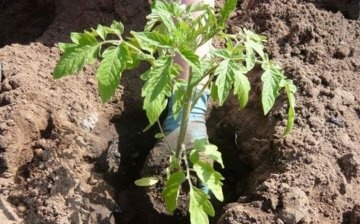
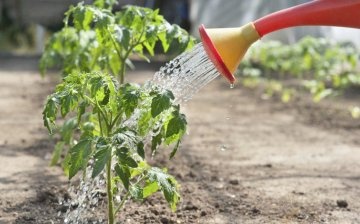
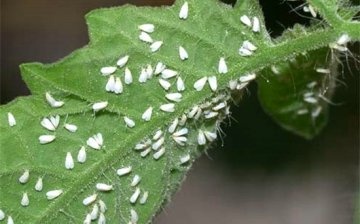






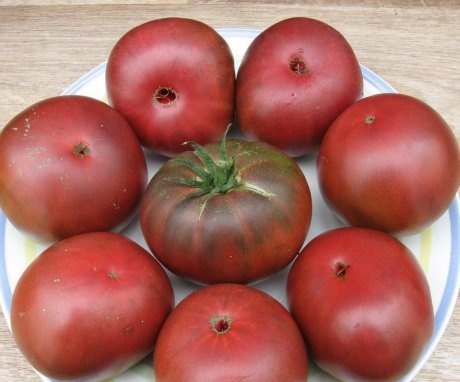
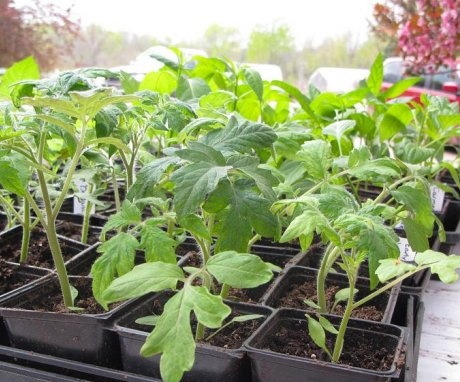
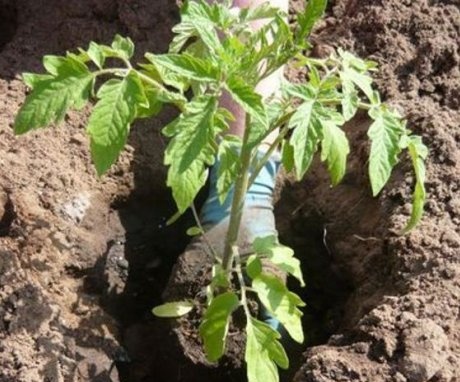
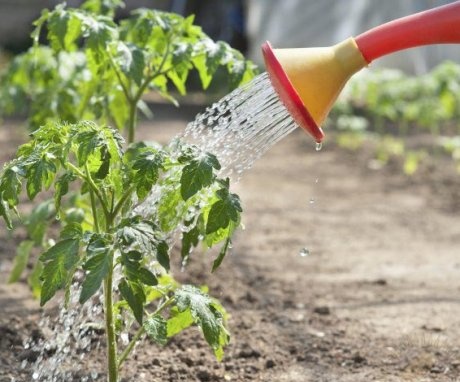

A tomato weighing up to 350 g is practically the size of a "bovine heart", if not larger. A very interesting variety that, with proper care, can produce a harvest sufficient for food and canning from a small number of bushes. Saving space in the greenhouse is evident
Nooo ... For canning, it will not work - it simply won't fit into a jar, and it won't be tasty either. For pickles, tomatoes are needed that are dense and small - like "rocket" or "lady's finger". Then it turns out great. This variety is more salad.
Such tall tomatoes must be tied. I stuck poles 1.5 m long into the ground and tied a tomato bush to them as it grew. Moreover, he did not tie up tightly, so as not to pass the stem. You need to grab the bushes weekly. The note suggests leaving one stepson - this is the optimal amount for a good harvest.
My relatives call this tomato variety "Black Prince". They began to grow it in gardens relatively recently. I tried it, the taste is pleasant, a little tart. But the color of the pulp with its blackness is somewhat frightening.